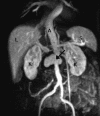Salmonella enterica serotype Choleraesuis: epidemiology, pathogenesis, clinical disease, and treatment
- PMID: 15084503
- PMCID: PMC387403
- DOI: 10.1128/CMR.17.2.311-322.2004
Salmonella enterica serotype Choleraesuis: epidemiology, pathogenesis, clinical disease, and treatment
Abstract
Nontyphoid Salmonella strains are important causes of reportable food-borne infection. Among more than 2,000 serotypes, Salmonella enterica serotype Choleraesuis shows the highest predilection to cause systemic infections in humans. The most feared complication of serotype Cholearesuis bacteremia in adults is the development of mycotic aneurysm, which previously was almost uniformally fatal. The advances in diagnostic techniques, surgical care, and antimicrobial therapy have greatly improved the survival of these patients. However, the recent emergence of serotype Choleraesuis that is resistant to ampicillin, chloramphenicol, trimethoprim-sulfamethoxazole, and, notably, fluoroquinolone antibiotics has aroused concern about the use of these agents for the empirical treatment of systemic infection caused by this organism. In view of the serious implications of the situation, the chain of transmission and mechanism of resistance should be carefully studied to reduce the spread of infection and threat to human health. To date, there are no vaccines available to prevent serotype Choleraesuis infections in humans. The availability, in the near future, of the genome sequence of serotype Cholearesuis will facilitate the development of effective vaccines as well as the discovery of new targets for novel antimicrobial agents.
Figures


Similar articles
-
Extraintestinal focal infections in adults with Salmonella enterica serotype Choleraesuis bacteremia.J Microbiol Immunol Infect. 2007 Jun;40(3):240-7. J Microbiol Immunol Infect. 2007. PMID: 17639165
-
The emergence in Taiwan of fluoroquinolone resistance in Salmonella enterica serotype choleraesuis.N Engl J Med. 2002 Feb 7;346(6):413-9. doi: 10.1056/NEJMoa012261. N Engl J Med. 2002. PMID: 11832529
-
High prevalence of ceftriaxone resistance among invasive Salmonella enterica serotype Choleraesuis isolates in Thailand: The emergence and increase of CTX-M-55 in ciprofloxacin-resistant S. Choleraesuis isolates.Int J Med Microbiol. 2018 Jun;308(4):447-453. doi: 10.1016/j.ijmm.2018.03.008. Epub 2018 Mar 23. Int J Med Microbiol. 2018. PMID: 29605531
-
Bacteremia caused by Salmonella enterica serotype Choleraesuis in Taiwan.J Microbiol Immunol Infect. 2006 Oct;39(5):358-65. J Microbiol Immunol Infect. 2006. PMID: 17066196 Review.
-
Nontyphoid salmonella infection: microbiology, clinical features, and antimicrobial therapy.Pediatr Neonatol. 2013 Jun;54(3):147-52. doi: 10.1016/j.pedneo.2013.01.010. Epub 2013 Mar 1. Pediatr Neonatol. 2013. PMID: 23597525 Review.
Cited by
-
Effect of Antimicrobial Exposure on AcrAB Expression in Salmonella enterica Subspecies enterica Serovar Choleraesuis.Front Microbiol. 2013 Mar 14;4:53. doi: 10.3389/fmicb.2013.00053. eCollection 2013. Front Microbiol. 2013. PMID: 23503095 Free PMC article.
-
Early immune response following Salmonella enterica subspecies enterica serovar Typhimurium infection in porcine jejunal gut loops.Vet Res. 2009 Jan-Feb;40(1):5. doi: 10.1051/vetres:2008043. Epub 2008 Oct 16. Vet Res. 2009. PMID: 18922229 Free PMC article.
-
Complete Genome Sequence of Salmonella enterica Serovar Choleraesuis Vaccine Strain C500 Attenuated by Chemical Mutation.Genome Announc. 2014 Oct 9;2(5):e01022-14. doi: 10.1128/genomeA.01022-14. Genome Announc. 2014. PMID: 25301657 Free PMC article.
-
Royal jelly acid: preparation, metabolism and therapeutic potential.Front Pharmacol. 2025 May 26;16:1561351. doi: 10.3389/fphar.2025.1561351. eCollection 2025. Front Pharmacol. 2025. PMID: 40492134 Free PMC article. Review.
-
Draft Genome Sequence of a Salmonella enterica subsp. enterica Serotype Choleraesuis Strain Isolated from the Pulp of Muskmelons.Microbiol Resour Announc. 2021 Mar 11;10(10):e00009-21. doi: 10.1128/MRA.00009-21. Microbiol Resour Announc. 2021. PMID: 33707316 Free PMC article.
References
-
- Abe, A., and K. Kawahara. 1995. Transcriptional regulation and promoter sequence of the spvR gene of virulence plasmid pKDSC50 in Salmonella choleraesuis serovar Choleraesuis. FEMS Microbiol. Lett. 129:225-230. - PubMed
-
- Abe, A., H. Matsui, H. Danbara, K. Tanaka, H. Takahashi, and K. Kawahara. 1994. Regulation of spvR gene expression of Salmonella virulence plasmid pKDSC50 in Salmonella choleraesuis serovar Choleraesuis. Mol. Microbiol. 12:779-787. - PubMed
-
- Aguado, J. M., M. L. Fernández-Guerrero, F. La Banda, and J. L. G. Garcés. 1987. Salmonella infections of the abdominal aorta cured with prolonged antibiotic treatment. J. Infect. 14:135-139. - PubMed
Publication types
MeSH terms
Substances
LinkOut - more resources
Full Text Sources
Medical

